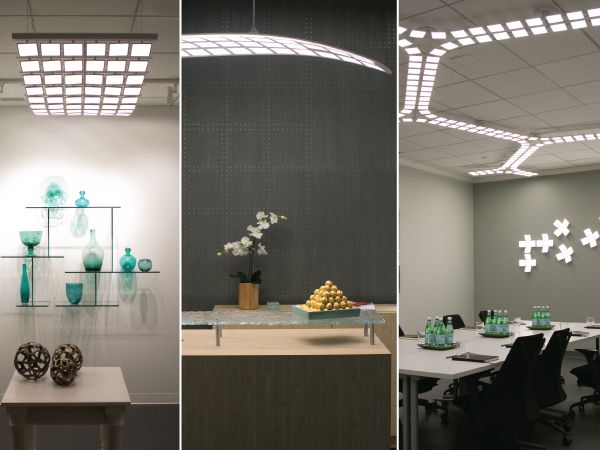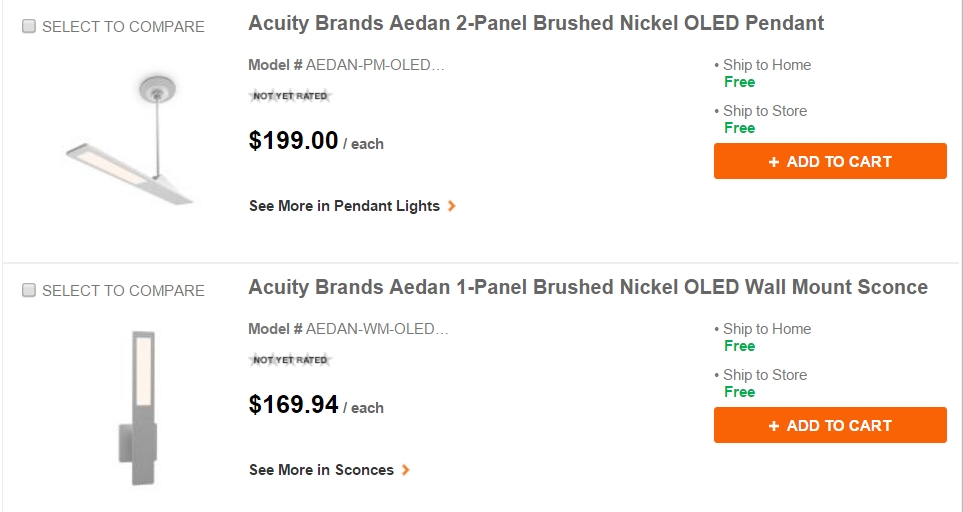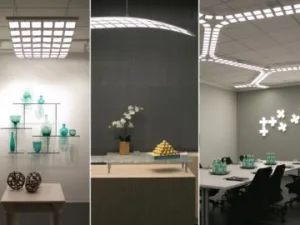The 2015 Printed Electronics Conference (Santa Clara, CA, November 17-20) session on Opportunities in the Lighting Industry included speakers from Acuity Brands, Konica Minolta and Universal Display. While each of these three firms represents a different level in the OLED supply chain (Acuity Brands – light fixtures/luminaires, Konica Minolta – OLED lighting panels, Universal Display – OLED materials) each of the three presenters covered developments in OLED materials affecting their products as well as their core businesses. Of course these ongoing OLED materials developments also have implications for OLED displays.
Acuity Brands speaker, Mike Lu, Director OLED Technology, presented a talk titled “Recent Developments in OLED Lighting“. Lu noted that Acuity’s lighting products are based on OLED panels from LG Chem. The performance of these panels currently yields a luminous efficacy of 55-60 lm/W with a Color Rendering Index (CRI) of 88-90. Acuity projects that their new generation panels just beginning to ship now will have luminous efficacy of 80-90 lm/W and a CRI of 90.
The Acuity speaker then went on to cite recent research by Prof. Jian Li’s group at Arizona State University on narrow linewidth phosphorescent OLED emitters which enables substantially narrower luminescent spectral linewidth. Lu noted that OLED emission linewidths reported by the ASU group with full width half maximum (FWHM) values <30 nm rivals the narrow linewidth emission obtained using quantum dots. The upshot of this result is that such reduced emission linewidth can produce much higher color saturation in OLED displays. Also, if a saturated narrow red emitter was used in a lighting panel, the luminous efficacy of radiation (LER) can be increased by up to 10% since fewer photons would be emitted in the spectral region where the eye is not sensitive.
Lu also cited research from National Tsing-Hua University, Taiwan, by Prof. J.H. Jou’s group that is aimed at using many, that is greater than 3, say 4, 5, or 6, emitting material layers to more accurately deliver the more continuous emission spectrum associated with a black body emitter. To date Prof. Jou’s group has focused on low correlated color temperature (CCT) <2000K OLEDs that emulate candle light. These low CCT OLEDs can be used to address the putative hazard of blue light at night.
In addition to discussing these OLED material advances, Lu presented examples of Acuity’s most recent OLED commercial lighting product offerings. These products incorporate both rigid and bendable OLED panels as large as 2×8 inches. Acuity offers a relatively wide range of pendant, sconce and larger format ceiling mounted OLED luminaires (see illustration below).
 Source: Acuity Brands
Source: Acuity Brands
Most interesting to me is that Acuity is working with Home Depot to bring OLED to consumers with a range of OLED lighting offerings. The Acuity OLED light fixtures at Home Depot (see examples in illustration below) range in price from $165 to $320.
 Source: Home Depot
Source: Home Depot
In his presentation, Lu also reported on Acuity’s lighting product development efforts directed toward luminaires integrating both OLED and LED solid state light sources. Lu provided Acuity’s rationale for integrating OLED with LED lighting stating “OLED for satisfying psychological appetite for brightness” and “LED for high performance indirect uplight for close-to-ceiling applications and wide luminaire spacing”. Acuity Brands has been committed to developing and offering OLED lighting products for a considerable time now and is apparently continuing their commitment to deliver high quality solid state lighting products to consumers at consumer price points. – Phil Wright

